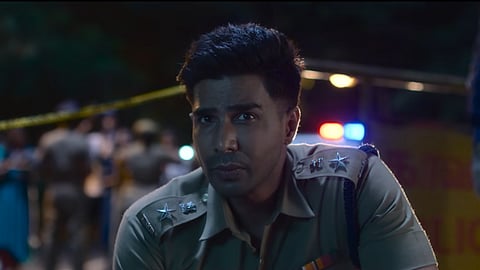Aaryan Movie Review: Goes for the kill, settles for far less
Aaryan Movie Review(2 / 5)
Aaryan Movie Review:
Writers are an imaginative lot, and sometimes, this can lead to the delusion of grandeur. Some can believe that their personal failures as a creator are a conspiracy designed by the world around them to silence their voices. The same world that should thank its lucky stars to have them in its midst. Delusional or not, creative license isn’t just relegated to the art, but sometimes, to the artist, too. And that is why director Praveen K’s Aaryan is a fascinating case study about a writer who believes he is the best, but finds himself at the receiving end of neglect, insults, and disdain. Now, what does a writer like this do? Put his head down and write more? Resign to his fate and accept his failure? Or… start killing people in the hopes of creating the perfect crime that will be the premise of his tour de force book?
Director: Praveen K
Cast: Vishnu Vishal, Selvaraghavan, Shraddha Srinath, Maanasa Choudhary
Aaryan is all about writer Alagar (Selvaraghavan), who decides to go on a serial killing spree to prove to the world that a perfect crime is possible. Police officer Arivudai Nambi (Vishnu Vishal) wants to put an end to this madness. Journalist Nayana (Shraddha Srinath) aims to reveal the method behind this madness to her audience. However, all of this is similar to the books Alagar has written: perfect in his head, but doesn’t translate into being bought by his audience.
But what truly works for the film is its fantastical premise. It sets up Alagar as a smart alec, who announces his serial killing plans to the world even before enforcing his first kill. He charts out the entire blueprint of his murder spree. It is a clear challenge to the police to catch him if they can, and that is where Nambi comes in. While the premise is terrific, the film falters in the way these two worlds collide. For the longest time, the cops in Aaryan are mere spectators to the crimes orchestrated by Alagar. Even the smart Nambi, whose claim to fame is the capture of another serial killer from Kodaikanal, doesn’t exhibit a lot of smarts in this cat-and-mouse game. He is playing catch-up to a laborious plan that is bereft of logic, and has high stakes… only on paper.
For any investigative thriller worth its salt, it isn’t enough if the thrills are in place. The investigation needs to be on point, and it must, ideally, outsmart the audience and subvert their expectations. Unfortunately for Aaryan, it is the police that are constantly hoodwinked, and they come across as both clueless and listless. It doesn’t help that the film feels torn between wanting to exalt the antagonist and grounding him at the same time. It doesn’t help that the film feels torn between making the stoic cop into a masala film hero and grounding him at the same time. This contradiction affects Aaryan greatly because every time the writing throws a smart subversion, it is soon followed by a template scene that is not just distracting but so out of place that it borders on unintentionally funny.
While Alagar’s journey, despite being one of a warped serial killer, is straightforward, Nambi’s journey is written too superficially for the ‘pained hero trying to find an out’ trope to really work. Once again, it isn’t that the film doesn’t have promise, it is just that it fails to live upto it. For example, we are introduced to Nayana (Shraddha Srinath), a fearless journalist who is forced to succumb to the melee of social media validation. She is a force to reckon with, and yet, after a while, her arc is pushed to the sidelines. Even though she cracks the case much before the cops, we are told of it only in the last act. Why? Similarly, Anitha (Maanasa Choudhary), who is the estranged wife of stoic cop Nambi, is shown as a forensic expert. In fact, their meet-cute happens during the investigation of a serial killer in Kodaikanal. And yet, she is never brought back into the narrative, and is only used as the emotional anchor of Nambi when he finally realises that control is an illusion. And… in the very next scene, he is discussing the case and has an emotional outburst in front of Nayana. This oscillation in Nambi’s mind needed time to get used to, and Aaryan could have been a compelling exploration of a mind mired in the gritty and dark underbelly of mindless killings and violence. Instead, it is cramped into a narrative that is lethargic despite having a ticking clock woven into it.
While comparisons to Ratsasan are par for the course, especially with Vishnu Vishal being joined by composer Ghibran and editor San Lokesh, Aaryan is a completely different film. But just like Ratsasan, Ghibran, once again, wonderfully enhances the tension of the investigation with the score. Unfortunately, unlike Ratsasan, Aaryan’s pacing is a couple of notches lower than the score, and sometimes, it feels off-key. The mood of the film is on point, and cinematographer Harish Kannan ensures the police procedural is filled with hues of darkness, which adds to the intrigue.
In fact, Aaryan would have worked even better if it were a drawn-out series where we understood the machinations of the cop and the killer, who are both loners, passionate, underappreciated... basically, two dogged sides of the same coin. But the makers have a different idea. Considering this is a serial killer film that is not a whodunnit, but a ‘why-dunnit’ or even a ‘how-dunnit’, a lot was riding on the unpacking of all the information. The fact that this comes as an exposition and not the result of a true-blue investigation adds to the disappointment. While the reasoning is seemingly interesting, it is only an extension of a writer’s delusion of grandeur, and painting it with any other colour feels detrimental. Interestingly enough, the film also pushes a similar thought, but it comes after the undue elevation of the cause, which makes us wonder who we should throw our weight behind. And unfortunately, as it stands, Aaryan ends up a classic case of the should-haves and could-haves overshadowing what it actually turns out to be.


